The inclusion of houseplants has significantly increased since the pandemic as people started spending more time staying in their homes. In this guide, we'll go through the benefits of air purifying plants and our suggestion on some of the best ones to grow in your home.
More...

Research has shown that indoor air is often more polluted compared to the outer air. This pollution is generally instigated by the presence of formaldehyde and benzene in synthetic building materials.
Additionally, personal care products, household cleaning chemicals and pesticides also contribute to the cause and threaten our living. The presence of household plants benefits by purifying the indoor air while adding an aesthetic touch to the overall decorum.
To accentuate the efficiency of plants in purifying the indoor air, consider adding a humidity tray to help the plants in the purifying process. Their presence has proven its worth in improving your home's air quality.
Positioning the plants in places having a high probability of air pollutants would be beneficial to the cause. Also, clean the leaves regularly to enhance their absorption quality. Continue reading through the blog to create a difference in indoor air quality with the help of air purifying plants.
How do plants contribute to air purification?
- The process of purifying indoor air involves two main processes namely phytoremediation and photosynthesis. The first process involves the absorption of air pollutants and volatile organic compounds through roots and leaves.
- These pollutants are further broken through metabolic processes followed by trapping of those in the soil. Plants having large leaves can facilitate transpiration rate at a much faster rate. Those plants can contribute effectively to the process of purification.
- Indoor plants can successfully reduce the number of harmful air pollutants such as benzene, formaldehyde, ammonia, xylene and trichloroethylene. Trichloroethylene is mostly present in varnishes and paints, benzene is found in dyes and tobacco as well, xylene is released from car exhaust and lastly, ammonia is present in floor waxes and window cleaners. It will be difficult to escape from the ill effects of these pollutants in absence of common household plants.
- The process of photosynthesis functions by the removal of harmful gases from the air through the absorption and breaking down of carbon dioxide exhaled by human beings.
The soil also contributes additionally by functioning as a filter and trapping the heavy metals and particulate matter that would otherwise affect the surrounding air inside. Below discussed are some effective household plants that can effectively purify the indoor air.
10 Best Air Purifying Plants to Grow
1. Snake plant (Dracaena trifasciata)
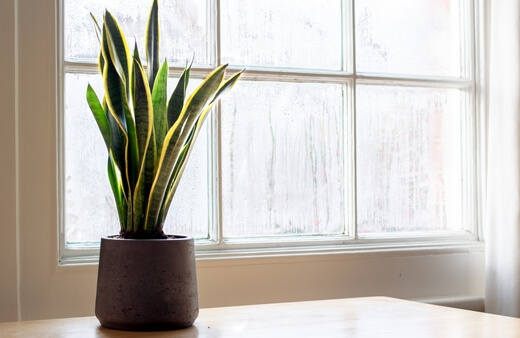
Snake plants also known as mother-in-law's tongues require minimum attention to grow in your indoor environment. It is considered one of the best indoor plants for clean air. Their ability to release moisture through the process of transpiration makes it one of the most recommended indoor plants for purifying your inner environment.
It can be placed in bedrooms or living rooms to function effectively. However, bathrooms are the most suitable place to place them as they can survive in humid conditions under low light. These plants are known to filter out the pollutants such as benzene and formaldehyde and nitrogen oxides.
These plants release the maximum amount of oxygen at night helping you to experience a good night's sleep. Be mindful while watering these plants as overwatering them can cause rot to the roots in most soil.
2. Spider plant (Chlorophytum comosum)

Spider plants function by absorbing the pollutants and converting them further into food followed by diffusing clean air into the surrounding. Spider plants are particularly recommended if you have pets in your house.
This is because spider plants are one of the few non-toxic house plants that cause no harm to pets. They have a high transpiration rate that helps to increase humidity in the air which eventually benefits by reducing the probability of health issues.
They are known for eliminating the presence of xylene and carbon monoxide in the indoor air. Improving your indoor air is quite essential which is why servicing your air conditioning is so important.
3. Bamboo palm (Chamaedorea seifrizii)
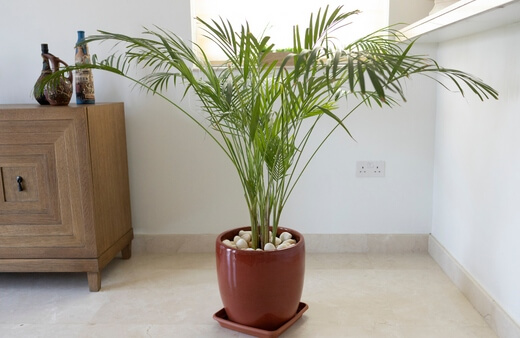
Like other house plants bamboo plants perform their function by carefully removing the volatile organic compounds from the air. It is effective in removing pollutants that are mostly found in paints, cleaning products and furniture that would otherwise have adverse effects on human health.
The roots of these plants absorb the pollutants followed by the breaking down of toxins hence this process is termed phytoremediation. Through the process of photosynthesis, they diffuse clean oxygen into the air.
Other than functioning as a purifier they also function as a natural humidifier that has added benefits during the winter season. They are evidenced to thrive in places where there is a lack of direct sunlight.
Thus, it is advised to position them accordingly and prune them regularly due to their rapid growth. After the spider plant, it is another house plant that is safe for pets.
4. English Ivy (Hedera helix)
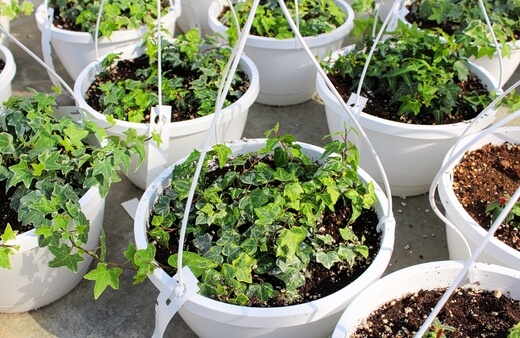
It is indeed a high-maintenance house plant that is effective in removing harmful toxins from the indoor air. Several maintenance tips include watering the plant carefully as it does not function properly in presence of standing water.
Likewise, you may need to work on the position of this plant more often as it requires direct sunlight to function at its best. In absence of the same, it is likely to attract pests that can eventually hamper its overall functioning.
Like other house plants, this one also has proven to increase the humidity level in the air which would specifically prevent respiratory issues in human beings. Despite being a high-maintenance plant it is a demanding anti-pollution plant. Further, it is evidenced to relieve 55% of the harmful toxins from the air.
5. Aloe Vera (Aloe perfoliata var. vera)
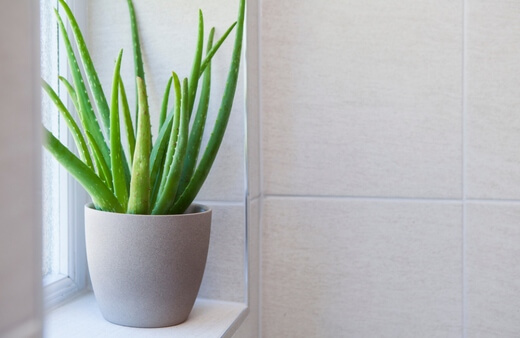
Having an Aloe Vera plant has its additional benefits. It requires less maintenance and its propagating nature is able to produce more Aloe Vera plants in a short period. It has wound healing, anti-inflammatory and antibacterial properties that can provide additional benefits apart from the purification of indoor air.
These air cleaning plants are effective in eliminating pollutants like toluene, formaldehyde and benzene that are generally found in cleaning products, furniture and carpet. They are an effective ingredient for hair and skin that helps to maintain a great complexion.
6. Peace Lily (Spathiphyllum)

These are one of the most popular air purifying house plants that are widely used in most households. They are exceptionally known for eliminating the pollutants released by electronic gadgets.
Additionally, they are known for removing formaldehyde and benzene similar to that of the aloe Vera plant that provides clean air for you to breathe in.
They require less maintenance to function effectively on a daily basis. Similar to other plants, it is also known for enhancing the amount of humidity in the air, especially during dry seasons.
They are ideal for the ones who have a busy schedule to follow as they require minimum attention and can tolerate a certain amount of neglect on their part.
However, this characteristic of theirs should not be taken for granted in the long term, as a consequence, the leaves would start turning brown which would appear as a warning sign.
They tend to thrive in dry soil, positioning them under indirect sunlight and maintaining consistently moist soil would bring the best out of them. Lastly, their delicate white flowers and lush green leaves add an aesthetic touch to the overall look and nature of any room.
Despite the plenty of benefits provided by the plants, you should not consider keeping one if you have a pet in the house. They are evidenced to have poisonous effects on household pets, especially dogs and cats.
Grow your own at home with the help of our in-depth guide to growing Peace lily.
7. Weeping fig (Ficus benjamina)
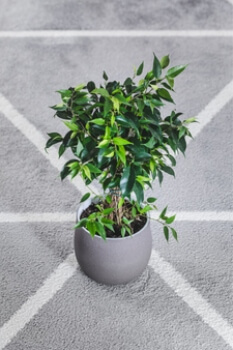
Weeping fig, an air purifying plant, has been known since the Victorian period and is popular for combating pollutants like trichloroethylene, toluene, formaldehyde and benzene which are generally found in carpets, curtains and furniture.
They also require low maintenance and don't require regular watering to keep functioning at their best. It brings a sense of calmness and helps to reduce stress in the environment promoting well-being.
Their delicate branch and lush green leaves are likely to contribute to the factor of visual enhancement in a room.
They share a lifespan of a maximum of five years and can be further grown into a full-fledged tree making an astounding addition to your indoor space. They are not adaptable to change and are supposed to be placed under indirect sunlight for effective results.
8. Chrysanthemum
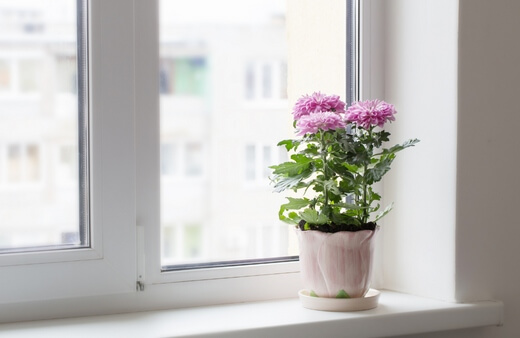
This is another recommended air purifying plant that is known for removing a host of toxins from the air. In addition to its benefits, it has a cultural significance that symbolises joy and love in multiple cultures which adds meaning to its addition in the indoor space.
They can be grown in both indoor and outdoor areas. They require relatively less maintenance to function effectively at their best. They are known to combat trichloroethylene, benzene and formaldehyde from inhaling air.
Further, they provide a positive impact on your mental health by reducing stress and anxiety and enlightening your mood to cheer your day with a positive feeling. The plant thrives in the presence of sunlight, hence sunbathed windows would be a great place to position them for effective results.
9. Chinese evergreen (Aglaonema)

This is another antipollution house plant that is effective in eliminating pollutants like formaldehyde, trichloroethylene and benzene from the surrounding air. With ongoing busy schedules, it becomes difficult at times to take care of plants effectively.
Chinese evergreen is immune to low maintenance and care making it an ideal choice for busy garden lovers. Additionally, it has extreme drought tolerance which saves you from the guilt of forgetting to water plants regularly.
Their variegated propagation and lush green leaves attract the eyesight of the visitors and guests in your place enhancing the aesthetic vibe of the surrounding. They share a long life span and are evidenced to thrive in extreme indoor conditions.
10. Azalea (Rhododendron spp.)
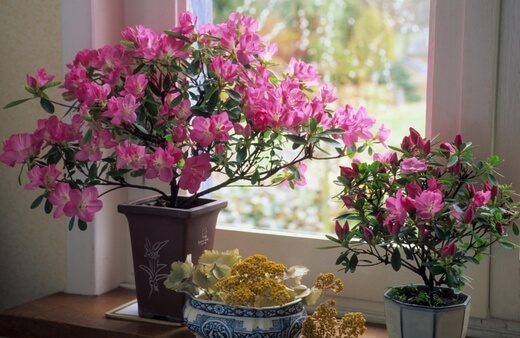
Azalea is a dual purpose plant that effectively counters the ill effects of xylene, formaldehyde and benzene from the ambient air. Its attractive blooms tend to adore the aesthetic vibe of the room while uplifting your mood simultaneously.
It helps to deal with mood swings while reducing the impact of anxiety and stress. They are likely to prosper in areas that receive indirect sunlight and maintain a cool temperature.
The bright rays of sunlight end up burning their leaves which further limits their functioning to a great extent. Similar to Chinese evergreens they can also be grown in both indoor and outdoor areas.
They are also used as a sign of love and happiness in more than one culture which adds cultural significance to its addition indoors.
For more collections of different types of plants, refer to our list below:
Author Bio:
Hello, I’m Erika Rhein, a professional writer, blogger, and passionate traveller. I write on diverse niches, including home or office improvement, lifestyle, and fashion. I always aim to present users with valuable and instructive articles in a compelling format, endeavouring to achieve a difference through my writing.Breathe in Cleaner Air by Growing these Air Purifying Plants in Your Home
When you aim at purifying indoor air, houseplants are a great choice to opt for. However, the claim of replacing indoor air purifiers with house plants has been scrutinized by researchers and came up with a flaw regarding the effectiveness of using houseplants for purifying purposes.
Several researchers argued that the rate of air exchange is faster in a building compared to those sealed chambers which makes the removal of volatile organic compounds erroneous in real life. Plenty of household plants would be able to eliminate the toxins more effectively.
The discourse regarding the efficiency of houseplants in air purification is still open for further tests and examination. But that doesn’t mean you should stop considering providing space to the houseplants as they share plenty of added benefits that make it worth adding to your indoor space.
Published on February 20, 2023 by Lorri Hopkins
Last Updated on January 29, 2024




